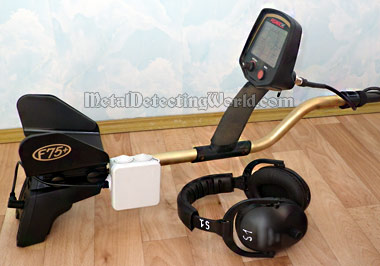The Best Way to Mount a Wireless Transmitter onto Your Metal Detector
Tutorial for Detectorists: How To Make Your Headphone Operation Wireless and Protect a Transmitter from Damage and Grime, page 1
by Sergei UpstateNY, last time modified:
A $2.50, simple setup gives you freedom from the headphones cable and ensures protection of your enclosed wireless transmitter against dust, mud, and light rain.

Today, a few manufacturers of metal detectors and accessories produce Universal Wireless-Headphones Systems (wireless headphones + wireless Transmitter) and Universal Wireless Audio Modules (wireless Transmitter + Receiver with a socket for the wired headphones) for users of the non-wireless metal detectors equipped with the wired headsets. The wireless audio kits definitely make life a whole lot easier for those detectorists who want to be free from the headphone cords and gain more maneuverability and comfort (physical and mental). All wireless headphones, wireless audio systems and modules on today's market are listed on THIS PAGE
Why To Use a Water-Resistant Enclosure for a Wireless Transmitter?
Wireless transmitters for metal detectors are specially shaped to be mounted onto any metal detector, either onto its middle shaft or near the armrest, by means of rubber O-Rings, bands or Velcro strips provided by manufacturers. This is certainly the quickest and most convenient way to attach the wireless transmitter to your detector and put it into action; however, this is not the most secure way to prevent the transmitter from getting damaged. It can be messed up either by accidental hitting the surface rocks or getting into a puddle of mud when your detector falls on its side if placed on uneven ground surface.
A minor nuisance may occur when the transmitter falls off the detector's shaft when the rubber O-Ring, band or Velcro strip eventually fails. Over time, the rubber O-Rings and bands break due to a destructive effect of Ultraviolet light which causes the rubber to dry, crack and crumble even though black materials typically resist UV damage better than other colors. The Sun's heat for extended periods and/or frequent temperature fluctuations may also contribute to destruction of the rubber O-Rings and bands. And the Velcro strips stop sticking when they catch lots of dirt and other debris (this is why they must be regularly cleaned by means of a vacuum and/or duct tape). At least, failing rubber bands and Velcro strips are not a big deal as they are cheap to replace and can be temporarily substituted with zip-ties in case one does not have a spare O-Ring or Velcro strip in the field. A bigger problem may occur where you less expect it.
All wireless transmitters of the audio systems and modules are WATER-RESISTANT and have the ingress protection (IP) ratings ranging from IP52 (protection against most dust and light rain (dripping water)) to IP64 (protection against any dust (dust tight) and heavy rain). Although "water-resistant" is NOT the same as "waterproof" (it starts with IP67), the wireless transmitters remain protected in the moderately wet weather conditions. A problem may arise when the unprotected wireless unit gets smeared with mud or is just covered with dust after having been used in real dirty/dusty field conditions, and, therefore, must be cleaned afterwards. Rinsing it with water is risky since the transmitter is not waterproof. The best thing one can do is to wipe the dirt off with a wet cloth. And here is where a huge trouble may come.
If one accidentally gets some dirt or even some microscopic soil particles inside a micro USB socket, it will be ruined quickly afterwards. The micro USB socket is the weakest part of any wireless transmitter because of 1) its tiny contact pins that are easily damaged by gritty dirt particles, and 2) its enclosing metal shell that can be quickly deformed by the connecting cable's continuous swinging (the way to prevent it will be described further below). A brush and a vacuum should be used to remove the tiny solid particles from the micro USB socket. And the socket should be frequently inspected.
Even though the wireless transmitter is designed to withstand adverse effects associated with various metal detecting conditions and situations, it is still a micro-electronic device and must be handled and treated with maximum care. The best way to keep it safe, long-lasting and not exposed to dust/dirt is to put it into a protective enclosure which can be affixed to the detector, somewhere near a headphone socket.